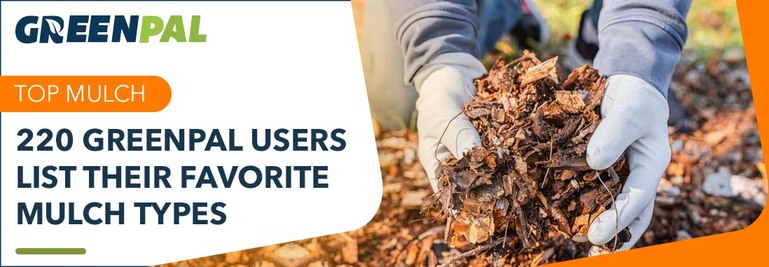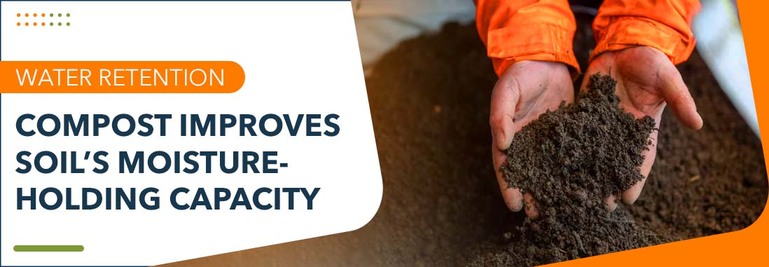220 Homeowners Share Their Top 10 Mulch Types

Mulch blocks out weeds and helps your plants thrive. It improves soil quality and moisture retention. There are all types of mulch, so we asked 220 homeowners to tell us what they're using to keep their garden beds and lawns healthy.
We'll take a look at what they're using and dig deep into why mulch matters.
Survey Results
Chipped or Shredded Wood - 67 votes |
Wood Shavings - 43 votes |
Pine Needles - 39 votes |
Straw - 12 votes |
Grass Clippings - 14 votes |
Compost - 22 votes |
Leaf Mold - 4 votes |
Gravel - 10 votes |
Black Plastic Mulch - 5 votes |
Rubber Mulch - 4 votes |
The Importance of Mulch

Mulching done well looks nice. Let's be honest. If you can maintain it well, which can be challenging, it provides a nice contrast to help your plant colors pop. While it could add to your curb appeal, there's more to mulch than aesthetics.
Mulch serves as a shield that aids in retaining moisture in the soil — an important factor, especially in arid regions or during the summer season. Mulch is useful for controlling weeds by blocking sunlight and preventing weed seeds from germinating; this can help reduce the amount of weeding required and decrease the competition for nutrients among plants. Starting to see how this plays out?
Yes, mulch might cost you upfront. Yes, it won't last forever. All that, and you're still lowering your water bill, helping your plants thrive, and saving yourself the headache of fighting weeds.
Mulch also enriches your soil. As it breaks down, it reintroduces nutrients back into the earth. This process fosters an environment for the growth of plant roots, resulting in their well-being.
Mulch helps keep the soil temperature stable throughout the year by acting as insulation – it keeps the soil cool during the summer and warm during the winter. This protective barrier shields plants from temperature changes that can harm their roots.
It also plays a role in preventing soil erosion caused by rain and wind.
10 Types of Mulch and What They're Made Of
Chipped or Shredded Wood

Find your favorite wood in a mulch: cedarwood, pine, cypress, and more make great mulches. Wood mulch's slow decomposition rates make it a long-lasting and economical option.
Other benefits of wood mulch include:
|
|
|
To promote the longevity of your garden bed, place 2 to 4 inches of shredded wood mulch around plants, with care to avoid contact, with tree trunks and plant stems in flower beds surrounding shrubs or beneath trees.
This mulch is ideal for use with trees and shrubs as perennial flower beds when looking for a durable mulch that improves the soil gradually.
Wood shavings
Wood shavings are a cost-effective mulch sourced from tree trimmings and branches, among other wood debris types. Unlike chipped or shredded wood, which decomposes quicker, wood shavings present a choice for where getting the right look is important.
Benefits of using wood shavings include weed control and moisture retention in gardens and larger planting areas, which adds a natural touch to your landscape design while enhancing soil quality with nutrient-rich decomposition over time.
Spread a thick layer of wood shavings around the plants in your garden beds and pathways for a nice, regulated look.
Pine Needles
Pine needles make a great mulch. It's a long-lasting option.
Pine needles offer advantages in gardening as they form a mulch layer that enables water and nutrients to seep into the soil and helps retain moisture effectively as they break down slowly, enhancing soil acidity. This feature benefits acid-loving plants such as azaleas and blueberries while promoting airflow to plant roots due to their resistance to compaction.
For great results, evenly distribute a 2 to 2-1/2-inch layer of needles in your garden beds and near bushes or flowers while ensuring ample space around the plant stems.
Straw Mulch

Straw mulch is commonly used in vegetable gardens, and for planted lawns, it consists of leftover stalk materials from grain harvest, such as wheat or barley.
Straw offers advantages by preventing weed growth and preserving soil moisture effectively. It's lightweight. It's easy to spread. Additionally, it serves as insulation for the soil to shield roots from temperatures. Its decomposition process reintroduces organic matter into the soil.
Spread a 2 to 4-inch layer of straw on top of the soil to protect it and provide insulation for plants, like crops or young grass shoots. Staw is ideal for vegetable gardens, as freshly sown lawns and spots that require affordable mulching solutions at a fast pace.
Grass Clippings
Home gardeners often opt for grass clippings as a free, readily available mulch choice. They commonly use it in vegetable gardens and to enhance the beauty of plants.
There are many benefits of using grass clippings, including retaining soil moisture to lessen the need for watering and releasing nitrogen into the soil as they break down to support plant growth healthily. It's crucial to spread grass clippings in layers to avoid compaction and mat formation that could hinder water and air from reaching the soil.
Apply a layer (about 1-inch-thick) of grass clippings on garden beds. Let the clippings dry out before spreading to prevent them from clumping. Use grass clippings in moderation, as excessive layers can encourage the growth of fungi.
Grass clippings are great for flower gardens, vegetable plots, or plants that thrive with the nitrogen produced as grass decomposes.
Compost

Compost is a fertilizer created from plant materials, like food scraps and yard waste, that acts as mulch and enhances the soil quality as it breaks down over time.
The advantages of compost include enhancing soil quality by enriching it with nutrients and encouraging growth while aiding in moisture retention and improving soil composition for better plant root development.
Spread a layer of compost 1 to 2 inches thick on the soil surface while being mindful not to cover the stems. It is suitable for use in flower beds, around trees and shrubs, and within vegetable gardens.
Leaf Mold
You can compost leaves until they turn into a crumbly material known as leaf mold — it's a great way to enhance soil moisture retention and the structure of clay or sandy soils.
Leaf compost offers advantages for gardens in climates by increasing water retention and improving heavy soil texture for easier gardening at a low cost through DIY leaf composting from your own yard.
Spread a layer of leaf mold. Make it 2 to 4 inches thick, concentrating on the spaces surrounding perennials, like flowers, bushes, and trees in your garden beds and vegetable patches, for optimal results.
Stone or Gravel

Stone or gravel mulch is often seen in xeriscaping and near plants that can withstand conditions well known for their ability to thrive in drought-prone environments.
Advantages of stone mulch include weed control and moisture preservation in climates while also regulating soil temperature through heat reflection during the day and heat release at night. This helps prevent organic mulch decomposition and the need for frequent replacement.
Place a 2 to 3-inch layer of gravel or small stones around your plants for the best results.
Stone or gravel is great for use in walkways —landscaping around plants that thrive in dry conditions, like succulents and cactuses.
Plastic Garden Mulch
Plastic mulch is an artificial material often used in vegetable gardens to inhibit weed growth and maintain soil hydration for crops that thrive in warm weather conditions.
Benefits of using plastic in agriculture include warming the soil by capturing heat to help crops such as tomatoes and peppers thrive and inhibiting weed growth by blocking sunlight exposure. However, this type of plastic can hinder water penetration, necessitating irrigation beneath the mulch.
Before you start planting in your garden bed or yard area, plastic covering the soil surface as a base layer is an idea to help with weed control and moisture retention for your plants' growth. Make sure to cut holes in the plastic where you place each plant so they can grow through it properly and receive adequate sunlight and water.
Don't forget to install irrigation lines under the plastic sheeting to ensure your plants receive moisture and nutrients for growth.
Rubber Mulch

Rubber mulch is used for landscaping and playground surfaces made from recycled rubber tires.
Rubber mulch is created from tires. It is a sturdy and enduring mulch that does not break down over time. It is commonly employed in playground settings and high-traffic locations because of its resilience.
Rubber mulch offers weed control. It retains moisture effectively without deteriorating.
The Importance of Using Mulch
Using mulch in your garden can provide advantages that greatly enhance its well-being and lifespan, making it an essential practice for gardeners everywhere.
Mulch plays a role in retaining moisture within the soil by minimizing evaporation effects in arid regions or hot summer periods. It lessens the necessity of watering while ensuring plants receive a supply of moisture throughout the season.
Mulching helps prevent weed growth by forming a barrier that blocks sunlight and inhibits weed seeds from germinating in your garden beds or areas you wish to keep free of weeds.
Organic mulches break down gradually. Enrich the soil with nutrients over time to enhance soil quality and fertility while promoting robust plant growth.
Maintaining a steady temperature for the soil is crucial for the well-being of root systems; using mulch helps to keep the soil warm during winter and cool during summer by providing insulation.
Mulch plays a role in preventing soil erosion by providing a layer over the soil to shield it from being eroded by wind and rainwater runoff — particularly beneficial on inclined surfaces and regions prone to heavy rainfall that could otherwise wash away essential topsoil nutrients.
Enhancing the aesthetics of gardens and landscapes goes beyond being practical; mulch also contributes to a refined appearance that enhances the vibrancy of plants by providing a cohesive and polished look.
Adding mulch to your garden design is crucial to establishing easy care for space. Whether you opt for inorganic options when selecting mulch can significantly improve the appearance and well-being of your garden.

Quick Summary
We asked 220 homeowners to share their mulch of choice, and we shared the top ten answers. Chipped or shredded wood was the favorite, but each of the top 10 from this list can help keep your lawn or garden healthy:
Chipped or Shredded Wood |
Wood Shavings |
Pine Needles |
Straw |
Grass Clippings |
Compost |
Leaf Mold |
Gravel |
Black Plastic Mulch |
Rubber Mulch |





 Share
Share











